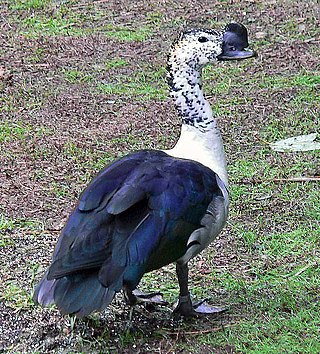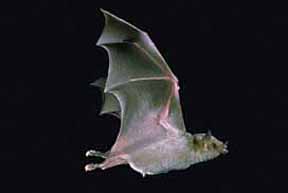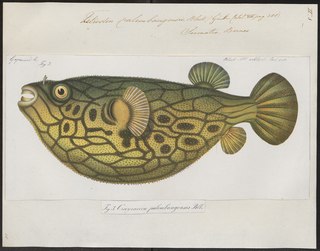
Sarkidiornis is a genus within the family Anatidae. Sarkidiornis is sometimes considered a monotypic genus with its sole member the knob-billed duck, a cosmopolitan species. Most taxonomic authorities, however, split the species into two:

The Saussure's long-nosed bats or Mexican long-nosed bats form the genus Leptonycteris within the leaf-nosed bat family Phyllostomidae. Like all members of the family, they are native to the Americas. According to ITIS, three species are currently recognised, though varying placements of the populations into species and subspecies will be encountered. The species recognised by ITIS are:

Homopus is a genus of tiny tortoises in the family Testudinidae, endemic to southern Africa. Three species have been moved to the genus Chersobius.

Sacalia is a genus of turtles in the family Geoemydidae. The genus was erected by John Edward Gray in 1870. The Sacalia is native to Southereastern China, Laos, and Vietnam. It was declared an endangered species of turtle by the IUCN Red List due to its illegal trade. The sacalia has a carapace of dark-brown color that permits it to camouflage to its habitat. They are believed to select the area of a river that better matches their color.

The genus Hypsugo contains many bats referred to as pipistrelles or pipistrelle bats. They belong to the family Vespertilionidae or vesper bats. They are primarily found throughout Asia, the Middle East, Mediterranean Europe, and North Africa, with a single (debated) species in Sub-Saharan Africa.

Pao palembangensis, is a species of freshwater pufferfish native to Thailand, Laos, Malaysia and Indonesia in Southeast Asia. Its commonly called the humpback puffer or dragon puffer. It is bred for aquaria as an ornamental fish because of its beautiful skin colouration and pattern.

Psammobates is a genus of tortoise erected by Leopold Fitzinger in 1835. This genus contains three species, all of which are indigenous to southern Africa.
Xenocypris is a genus of cyprinid fish found in eastern Asia. There are currently seven species in this genus, one, X. yushensis, being known only from fossils, and one, X. yunnanensis, which is critically endangered or recently extinct.
Copelatus acamas is a species of diving beetle. It is part of the genus Copelatus in the subfamily Copelatinae of the family Dytiscidae. It was described by Guignot in 1955.
Copelatus blatchleyi is a species of diving beetle. It is part of the genus Copelatus in the subfamily Copelatinae of the family Dytiscidae. It was described by Young in 1953.

Pao is a genus of mostly freshwater pufferfish with one species also occurring in brackish water. They are found in Southeast Asia. Until 2013, its species were generally placed in Tetraodon.
Semotivirus is the only genus of viruses in the family Belpaoviridae. Species exist as retrotransposons in a eukaryotic host's genome. BEL/pao transposons are only found in animals.
Onychostoma fangi is a species of cyprinid in the genus Onychostoma. It inhabits China and Vietnam and has a maximum length of 29.5 centimetres (11.6 in) and maximum published weight of 220.30 grams (7.771 oz).
Pao bergii is a species of pufferfish in the family Tetraodontidae. It is a tropical freshwater fish native to the Kapuas River drainage of Borneo in Indonesia.
Pao brevirostris is a species of pufferfish in the family Tetraodontidae. It is a tropical freshwater species native to Asia, where it is known from the Mekong basin and the Chao Phraya drainage. It inhabits marshes and swamps with dense aquatic plant cover, and the species is known to frequently hide between roots and among submerged foliage. Males of the species reach 9.5 cm SL, with females reaching 7.7 cm SL.
Pao hilgendorfii, sometimes known as Hilgendorf's puffer, is a species of pufferfish in the family Tetraodontidae. It is a tropical freshwater species native to the Mahakam basin in Borneo. The species was originally described as a member of Tetraodon but was moved to the then-new genus Pao in 2013.
Pao ocellaris is a species of pufferfish in the family Tetraodontidae. It is a tropical freshwater species native to Asia, where it is known from the Malay Peninsula. It was included in the genus Tetraodon until 2013.
Pao palustris is a species of pufferfish in the family Tetraodontidae. It was described in 2013 as Tetraodon palustris by Pasakorn Saenjundaeng, Chavalit Vidthayanon, and Chaiwut Grudpan from the Mekong basin of Thailand. FishBase lists this species as a synonym of Pao brevirostris, although ITIS lists Pao palustris as a valid species.
Ward's long-eared bat is a species of vesper bat in the family Vespertilionidae. It is found in mountainous regions of South Asia and adjoining regions.
Xenocypris fangi is a species of cyprinid in China, of the genus Xenocypris. It has a maximum length of 20.0 centimetres (7.9 in) and a common length of 17.0 centimetres (6.7 in). It inhabits the upper Yangtze and is considered harmless to humans.






